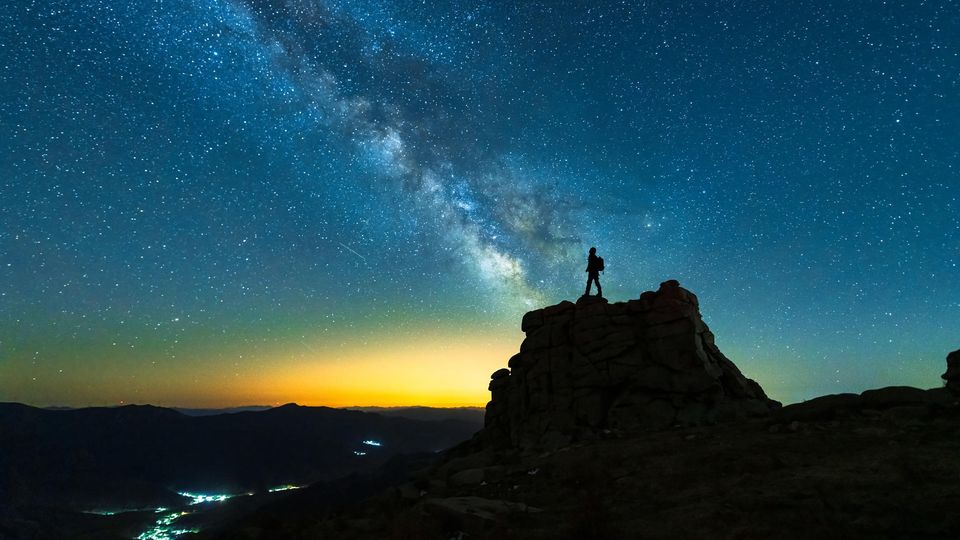The Night Science Institute Is Changing How Sciences Teaches Creativity
The Night Science Institute hopes to create a cultural shift in the scientific establishment.

Creativity has always been central to science, but Professors Itai Yanai and Martin Lercher believe it’s not being systematically taught or valued in today’s research ecosystems. In pursuit of a cultural shift, the scientists-turned-friends recently launched The Night Science Institute.
The Night Science Institute provides a hub of expertise, resources and practical tools that emphasize how science is more than simply testing ideas, but also about protecting and nurturing our ability to generate them. Yanai and Lercher use the interesting concepts of day science and night science – first described by the late Nobel Prize winner François Jacob – to illustrate this dynamic interplay.
While day science represents the structured and rational testing of hypotheses through experiments, night science – in contrast – is the creative realm where possible hypotheses and ideas are still forming.
“Night science is the ideation stage – coming up with new ideas. But those ideas mean nothing unless you test them, which is the role of day science,” Yanai, who is a professor in the Department of Biochemistry and Molecular Pharmacology, and at New York University (NYU), told Technology Networks. “Once you test, you then reflect on what you’ve learned, which leads you back into night science,” he added.
In this way, a cycle is formed: researchers move through night science, day science and back to night science again.
Yanai and Lercher have personally experienced the ebb and flow between night and day science throughout their careers. The duo first met in the early 2000s at the European Molecular Biology Laboratory (EMBL) in Heidelberg, Germany.
“We realized how easily we could talk to each other about science,” recalled Lercher, who is a professor in computational cell biology at the Heinrich Heine University in Düsseldorf, Germany. “We both have an open attitude toward new ideas and bold research plans, and neither of us is very constrained in the way we think.”
While collaborating on what Yanai called a “rebellious” gene expression project in Heidelberg, the scientists hit a brick wall. They describe moving through periods of “rigid work” where they had a specific plan to test, alternated with long periods lost in “dream worlds”, where they conjured up new questions and new ways to address the data.
This experience deviated sharply from the textbook scientific method they had been taught for so many years. In this project, they often lacked a clear problem or hypothesis to tackle and instead worked largely from observations that had puzzled them. Though it was abandoned, Yanai and Lercher argue that, in hindsight, it was not a failure. Instead, they believe this experience highlights a deeper disconnect between the idealized scientific method and the reality of how science is actually practiced – one that can even contribute to the frustrations and disillusionment of young scientists.
As they left EMBL and established themselves as respected scientists, Yanai and Lercher remained close friends – or science buddies, as they describe their relationship – and continued to collaborate with one another.
“We say everyone should have a science buddy – maybe even several. It’s simply someone you feel comfortable talking to, where you don’t have to worry about whether what you say might sound stupid. Because the truth is, if you never say anything that might seem silly, you’ll never come up with new ideas,” Lercher said.
In 2009, Yanai read François Jacob’s autobiography discussing the concept of night science. “The notion of 'night science' became a phrase that I liked using to refer to the creative process in science,” he said. “Over time, I realized that Martin and I were collecting tricks for how to do that.”
After publishing their book The Society of Genes in 2016, the pair were looking for a new project to work on together. “I pitched writing about night science to Martin, and he liked the idea,” Yanai said.
The resulting publications set in motion the creation of the Night Science Institute.
How to create a change in the culture of science
In 2023, a Nature study by Park et al. provided quantitative data suggesting that science and technology are becoming less disruptive. After analyzing over 45 million papers across 6 decades, the researchers found that papers, patents and even grant applications have become less novel relative to prior work. Park and colleagues also found that the gap between the year of discovery and the awarding of a Nobel Prize has increased in size, which they interpret as meaning today’s contributions are perhaps not measuring up to those of the past.
The study may have suggested a decline in innovation is occurring in science, but Yanai insisted that, for him and Lercher, this is not the “crux” of the issue. “We do not perceive a decline in creativity,” he said. “There are still many amazing discoveries being made every single day. Our concern is with the culture of science. It doesn’t take much digging to see the imbalance we’re describing.”
Yanai and Lercher argue that modern research culture tends to privilege day science, often at the expense of the creativity and exploration that night science requires. They suggest that there is excessive concentration on testing and producing deliverables, neglecting the equally important process of being generative, open, interdisciplinary and improvisational.
“Take the National Institutes of Health – the main funding agency in the US and a major driver of global science – for example. In its mission statement for the R01 – the main grant mechanism for research – the focus is on hypothesis testing, not hypothesis generation, which tells you a lot about what the culture values,” said Yanai.
“The same is true in education. Compare PhD training in science with graduate programs in the arts or design. In some art schools, students are required to take classes in creativity. But in science – which is just as dependent on creativity – there’s no equivalent. PhD students aren’t systematically taught ideation, or the practice of drawing inspiration across disciplines – like taking an idea from one field and applying it to another,” he continued.
The Night Science Institute’s goal is to shift the way people think about science.
“The reality is that creativity is not treated as a core skill in science. That is the imbalance we want to highlight and begin to correct,” said Yanai.
“There are two key aspects to this,” Lercher explained. “First, we want the creative process and discovery – not just hypothesis testing – to be more widely appreciated across the scientific ecosystem.”
“Second, we want to give early-career scientists concrete tools for creativity. Currently, most young researchers only pick up these tools if they happen to have a mentor who teaches them, and even then, it can take years. We think creativity should be taught systematically, like any other skill. Scaling this kind of teaching is a major priority for us,” he continued.
Helping night science reach scientists worldwide
In 2019, Yanai and Lercher launched the successful Night Science podcast, which boasts an average star rating of 4.9 on Spotify and 5.0 on Apple Podcasts. Using this platform, they invite imaginative thinkers to have an open conversation about the creative elements of science, with podcast alumni including the likes of Nobel Prize winner Professor Carolyn Bertozzi and geneticist Professor George Church.
The duo also publishes regular articles about the creative scientific process, and tips and tricks for accessing it, in journals such as Science, Nature Biotechnology and Genome Biology.
Later in 2021, Yanai and Lercher developed the Night Science Workshop, which explores both day and night science and teaches methods to generate ideas, question assumptions and approach problems differently. “In our workshops, we usually have a set of five or six sessions, where each one teaches a creativity tool, demonstrates how to use it and then we complete an exercise where participants get into pairs and practice using the tool,” said Yanai.
Since 2021, over 30 workshops have been delivered to scientists across the globe, including institutes such as Harvard Medical School in the US and the Wellcome Sanger Institute in the UK. Online reviews praise the sessions as being “innovative”, “inspiring” and “really game changing”.
Yanai and Lercher recently consolidated all these efforts into the Night Science Institute, which officially launched earlier this year. The team – which also includes Gretchen Vaughan as a board member, Dr. Oliver Bogler as CEO and an impressive advisory board – is now looking to scale their impact.
The institute is developing a “train-the-trainer” model, in which participants of the renowned Night Science Workshops will facilitate further training on workshop delivery, allowing the institute’s mission to reach beyond what Yanai and Lercher could accomplish alone while continuing their careers as professors.
Bogler proposed that, to change the culture of science, the Night Science Institute also needed to address changing how science is communicated – particularly in seminars. The novel Night Science Seminar Series, launching later this month, will ask presenters to include at least one “night science moment” where they reflect on the source of their inspiration and share how their work came to be.
“Too often, scientific talks present only the polished results – the ‘finished product’. What’s missing is any glimpse into how the ideas actually came about: the false starts, the sparks of inspiration, the interdisciplinary connections,” said Yanai.
In upcoming seminars, Yanai and Lercher will be presenting talks on the mechanisms of cellular plasticity in cancer drug resistance, and how optimal protein production led to understanding bacterial genome organization, respectively.
“Together, these activities – teaching, training, podcasting and writing – are our way of building momentum and restoring creativity to its central place in science,” said Lercher.
Currently, the Night Science Institute is self-funded; the workshops generate profit, which is then fed back into the institute to fund further workshops and activities such as the podcast. To help scale, the team is actively applying for grants, but this is not always an easy task.
“What we do falls outside the traditional research culture, which means it can be challenging to convince organizations like the National Science Foundation to provide support,” said Lercher. “But we think our mission is really important, and we want to try to get that message out in the future.”
In the long term, the team hopes to secure funding from private donors to help finance the institute’s work.
How to find your science buddy
For Yanai and Lercher, their own partnership illustrates the power of having a science buddy – someone with whom you can freely share ideas, explore uncharted questions and weather the uncertainties of the creative process.
One of the core goals of the Night Science Institute is to help others find their own science buddy, by providing not only the tools and guidance to foster creativity but also a supportive community where scientists can connect, experiment and inspire one another.
“Many of the methods we teach – ways of generating ideas, questioning assumptions or approaching problems differently – have been around for a century or more, passed down informally,” said Lercher.
By formalizing these opportunities, the institute seeks to ensure that no researcher has to navigate the challenges of discovery alone, and that creativity is positioned at the center of the scientific culture for generations to come.






